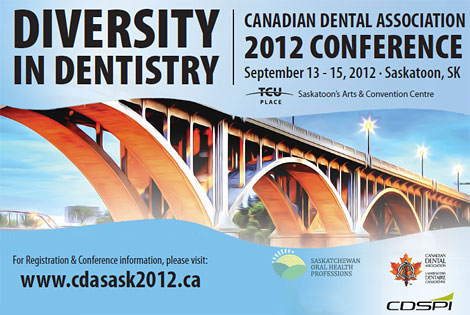
“The content for this edition of JCDA Express was created by Dr. Chris McCulloch of the University of Toronto. Chris is one of my heroes in the Canadian research community, and JCDA is committed to helping him and other Canadian researchers advance their work. Please click here to find out how you can help Chris and his team advance one of their key research projects.”
Dr. John P. O'Keefe
Director, Knowledge Networks

Clinical benefits of antimicrobial use in oral health care

In this edition of JCDA Express, Dr. Christopher McCulloch, professor and director of the Matrix Dynamics Group at the University of Toronto's faculty of dentistry, highlights 3 articles that examine the benefits of using antimicrobials in oral health care as assessed by improved clinical outcomes.
Introduction
Ideally, effective oral hygiene measures should involve a thorough reduction of the bacterial accumulations in dental biofilms. However, this presents a difficult challenge for various reasons, including the limited accessibility of conventional treatments provided by hand and ultrasonic instruments. Antimicrobial measures—such as systemic or locally delivered antibiotics, or oral antiseptics—may help reduce the reservoir of putative pathogens that contribute to periodontitis and other medical complications. The clinical benefits of these measures are examined in the 3 papers presented below.
The systematic review conducted by Zandbergen et al. (2012), demonstrates that use of systemic antibiotics as an adjunct to scaling and root planing (SRP) can improve the treatment of patients with chronic periodontitis, in terms of decreases in probing pocket depth (PPD) and gains in clinical attachment level (CAL). Goodson et al. (2012) examine the effects and interactions of 3 adjunctive therapies to SRP, including systematically and locally delivered antibiotics. Finally, in their study of intensive care unit patients, Ozçaka et al. (2012) demonstrate that use of an oral antiseptic may decrease the development of ventilator-assisted pneumonia.
|



|
Systemic antibiotic delivery
Zandbergen D, Slot DE, Cobb CM, Van der Weijden FA. The clinical effect of scaling and root planning and the concomitant administration of systemic amoxicillin and metronidazole: a systematic review. J Periodontol. 2012; May 21. (Epub ahead of print)
Full-text access to this article has expired.
JCDA Clinical Pearl: For treatment of chronic periodontitis, the use of systemic antibiotics, in addition to thorough mechanical treatment, should be considered and limited to patients with a high risk for disease progression.
Key Points:
-
For subgingival debridement in patients
with chronic periodontitis, SRP may not be effective in completely
removing bacterial biofilms that promote the development of
periodontal disease.
-
In addition to SRP, use of adjunctive
antimicrobial therapy has been proposed to improve clinical
outcomes and reduce the need for further treatment, at a
relatively low cost.
-
Twenty-seven studies evaluating the
clinical effect of combining systematic administration of
amoxicillin and metronidazole as an adjunct to SRP in the
treatment of periodontitis met the inclusion criteria for this
systematic review.
-
The main results showed an enhanced effect of antibiotic therapy as an adjunct to SRP, compared to clinical outcomes with SRP alone1: there was a full-mouth reduction in PPD of 1.43 mm and a full mouth gain in CAL of 0.94 mm, with the largest change observed in pockets originally measuring
 7 mm (reduction in PPD of 3.72 mm and mean gain in CAL of 2.6mm). 7 mm (reduction in PPD of 3.72 mm and mean gain in CAL of 2.6mm).
Reasons for recommending this article: This article describes the use of a powerful combination antibiotic regimen and provides good evidence that scaling and root planing may be effectively enhanced with appropriate antibiotic treatment. The use of systematic reviews can be particularly helpful for clinical decision making since when they are done properly and assess useful studies, the aggregate measure of the treatment effects can be more reliable than a single study.
|



|
Systemic and Local Antibiotic Delivery
Goodson JM, Haffajee AD, Socransky SS, Kent R, Teles R, Hasturk H et al. Control of periodontal infections: a randomized controlled trial I. The primary outcome attachment gain and pocket depth reduction at treated sites. J Clin Periodontol. 2012; 39: 526-36. doi: 10.1111/j.1600-051X.2012.01870.x. Epub 2012 Apr 18.
Full-text access to this article has expired.
JCDA Clinical Pearl: Patients with moderate periodontitis can benefit from systemically delivered amoxicillin plus metronidazole as an adjunctive therapy to SRP, in terms of gains in CAL and/or reduction in PPD.
Key Points:
-
The authors analyzed data from 187
patients with moderate periodontitis over a 24-month study period
to examine the effects of different combinations of adjunctive
periodontal therapies (systemically delivered amoxicillin plus
metronidazole, locally delivered tetracycline, and modified Widman
flap surgery) with SRP.
-
The benefits of adjunctive antibiotic
therapies vary with time: at 3 months, systemic antibiotics and/or
locally delivered tetracycline provided no benefit, with respect
to PPD reduction or CAL gain when compared to SRP alone. However,
at 6 months, patients provided with the systemic antibiotic
adjunctive treatment showed a significant difference in CAL gain,
and a CAL gain of 0.5 mm was maintained at 24 months.
-
PPD was significantly reduced at 24
months by both periodontal surgery and systemic antibiotic
therapy.
-
Local antibiotic therapy did not have a
significant additive effect on CAL gain and reduced PPD.
-
A factorial study design tested interaction between therapies and found only additive effects among adjunctive therapies; there was no evidence of synergism or antagonism.
Reasons for recommending this article:
This paper reports an interesting and well-designed randomized controlled study, and it highlights concerns about the lack of effectiveness of locally applied antibiotics in procedures that aim to improve gingival attachment levels. Notably, the use of randomization for assigning patients to the treatment groups and masked evaluations can help reduce problems with bias in clinical studies.
|

|
Chlorhexidine
Ozçaka O, Basoglu OK, Buduneli N, Tasbakan MS, Bacakoglu F, Kinane DF. Chlorhexidine decreases the risk of ventilator-associated pneumonia in intensive care unit patients: a randomized clinical trial. J Periodont Res. 2012; Feb 29. doi: 10.1111/j.1600-0765.2012.01470.x. (Epub ahead of print)
Full-text access to this article has expired.
JCDA Clinical Pearl: For mechanically-ventilated, intensive care unit (ICU) patients, oral swabbing with 0.2% chlorhexidine (CHX) 4 times a day, may be effective in reducing the pathogenic bacteria in oral biofilms, which can significantly reduce the development of ventilator-assisted pneumonia (VAP).
Key Points:
-
Previous studies2,3 suggest that dental plaque may be a
reservoir of the pulmonary respiratory pathogens that cause
ventilator-associated pneumonia (VAP) in mechanically-ventilated,
intensive care unit (ICU) patients.
-
This study—a randomized, double-blind,
controlled clinical trial—examined whether risk of VAP in ICU
patients is reduced by oral swabbing with 0.2% CHX 4 times a day,
compared to saline (control group).
-
Based on results from 61 patients, the
VAP development rate was significantly higher in the control group
than in the CHX group (68.8% versus 41.4%, respectively).
-
There were no significant differences in clinical periodontal measurements between the treatment groups, suggesting that clinical periodontal status does not have a significant effect on VAP development risk.
Reasons for recommending this article:
Intensive care patients who require ventilators are at increased risk for pneumonia. The use of chlorhexidine application to oral mucosa, which is readily managed in hospital settings, appears to reduce the risk of a very serious infection. This study provides a novel look at how application of chlorhexidine to control presumptive oral microbiota can lead to important improvements in non-dental infections.
|

|
References
-
Scannapieco FA, Stewart EM, Mylotte JM. Colonization of dental plaque by respiratory pathogens in medical intensive care patients. Crit Care Med. 1992; 20:740-45.
-
Fourrier F, Duvivier B, Boutigny H, Roussel-Delvallez M, Chopin C. Colonization of dental plaque: a source of nosocomial infections in intensive care unit patients. Crit Care Med. 1998; 26:301-8.
|

|
|

|
|
|
|
|
|
|

JCDA is the authoritative written voice of the Canadian Dental Association, providing dialogue between the national association and the dental community. It is dedicated to publishing worthy scientific and clinical articles and informing dentists of issues significant to the profession.

|
|

|
|

|
|

|
|

ITI Congress Canada
"New Technologies and Best Practices in Implant Dentistry"
September 21-22
Westin Harbour Castle, Toronto
ITI Education Week Toronto
"Best Practices in Implant Dentistry"
October 24-27
Holland Bloorview Kids Rehabilitation Hospital, Toronto
|
|
NOTES AND NEWS
JCDA would like to gratefully acknowledge the publishers of the selected articles, who have granted free access to the full-text papers until September 15, 2012.
Journal of Periodontology
(publisher: American Academy of Periodontology)
Journal of Clinical Periodontology
(publisher: Wiley-Blackwell)
Journal of Periodontal Research
(publisher: Wiley-Blackwell)
|
|
Search the JCDA Classified Ads
Looking for employment? Want to sell your practice? Classified ads offer the most effective way to reach all dentists and students in Canada.
|
|
Spread the word
Help spread the word about JCDA Express by telling your colleagues about it and reminding them to send CDA their email address.
reception@cda-adc.ca
|
|

|
|

|
|

Dr. John P. O'Keefe
Director, Knowledge Networks
jokeefe@cda-adc.ca
|
|



